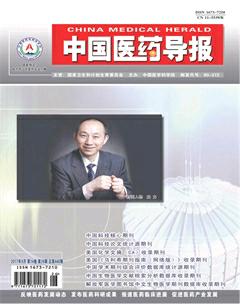2014~2016年我院抗过敏组胺药的临床应用统计
李玮
[摘要] 目的 了解2014~2016年陕西省汉中市中心医院(以下简称“我院”)抗过敏组胺药的临床应用情况,为临床合理用药提供参考。 方法 对2014~2016年我院抗过敏组胺药总销售金额及排序、抗过敏组胺药用药频度(DDDs)、日均费用(DDC)及排序比(B/A)等进行回顾性统计分析。 结果 3年来我院抗过敏组胺药总销售金额呈逐年降低趋势,尤其是第一代抗过敏组胺药降低尤为明显。各类抗过敏组胺药的销售金额排序变化不大,其中排名前两位药品均为枸地氯雷他定片和地氯雷他定片,西替利嗪滴剂排名逐年靠前,其他药物排序稍有变动。抗过敏组胺药DDDS排名前3位的主要是第三代药物,其中氯雷他定成分药始终排在前列。抗过敏组胺药西替利嗪滴剂的B/A值始终<1,氯苯那敏及异丙嗪的B/A值均>1。处方点评结果中涉及抗过敏组胺药不合理应用现象,主要存在的问题有药物联用不当、剂量不当、给药频次不当等,合计213例。 结论 我院抗过敏组胺药的DDDS排序基本趋向合理,但临床应进一步加强对第二、三代抗组胺的合理应用,以减少不合理用药现象。
[关键词] 抗过敏组胺药;销售金额;用药频度;用药分析
[中图分类号] R969.3 [文献标识码] A [文章编号] 1673-7210(2017)09(b)-0126-04
Clinical application statistics of antihistamine drugs in our hospital from 2014 to 2016
LI Wei
Department of Pharmacy, Hanzhong Central Hospital, Shaanxi Province, Hanzhong 723000, China
[Abstract] Objective To investigate the clinical utilization situation of antihistamine drugs in Hanzhong Central Hospital ("our hospital" for short), so as to provide references for clinical rational drug use. Methods The total drug sales amounts and sort, DDDs, DDC and sort ratio (B/A) of antihistamine drugs in our hospital from 2014 to 2016 were retrospectively analyzed. Results In the past three years, the trend of total drug sales amount of antihistamine agents decreased year by year, especially the first generation of antiallergic histamines. The sales amount sorting of all kinds of antihistamine drugs had few changes, Desloratadine Citrate Disodium Tablet and Desloratadine Tablet ranked the top two, rankings of Cetirizine raised year after year, other drugs sorting changed slightly. The top three DDDs of antihistamine drugs were the third generation of antiallergic histamines, drugs with Chloropressin composition always ranked the front of the list. The B/A values of Cetirizine Drops were always <1, and the B/A values of Chlorobenzene and Isopropyrazine were all >1. There were irrational use of antihistamine drugs in prescriptions, including improper drug combination, improper dosage, improper frequency for drugs giving, with total of 213 cases. Conclusion The DDDs sort of antihistamine drugs in our hospital is basically reasonable, but the clinical rational application of the second and third generation of antihistamine drugs should be further strengthened, in order to reduce improper use of drugs.
[Key words] Antihistamine drugs; Consumption sum; DDDs; Medication analysis
2005年6月28日,世界變态反应组织(World Allergy Organization,WAO)联合各国变态反应机构共同发起对抗变态反应性疾病的全球倡议,将每年的7月8日定为世界变态反应性疾病日,旨在通过增强全民对变态反应性疾病的认识,共同来预防变态反应的发生。临床上变态反应性疾病涉及的科室及疾病类型较多,如皮肤科、呼吸科、耳鼻喉科、儿科等,并以湿疹、过敏性哮喘、特异性皮炎、过敏性鼻炎等最为常见。近年来,随着环境和食品污染等因素的影响,变态反应性疾病的发病率升高明显,已成为目前多国关注的重点[1-3]。抗过敏组胺药是临床上治疗变态反应性疾病的一线用药,主要指组胺H1受体拮抗剂,在过敏性鼻炎、荨麻疹等变态反应性疾病的治疗中发挥着重要作用[4-5]。世界第一个抗过敏组胺药于1937年研发成功,至今其发展经历了第一代、第二代及第三代的改良品种,市场规模不断扩大,疗效不断提高,不良反应也逐步降低。随着抗过敏组胺药临床应用品种的迅速增多,不合理使用的情况也随之增加。为更好地了解陕西省汉中市中心医院(以下简称“我院”)抗过敏组胺药物的使用状况,本文对2014~2016年该类药物的应用情况进行回顾性分析,以期为临床合理用药提供指导。
1 资料与方法
1.1 一般资料
收集2014年1月~2016年12月我院药库系统数据库中抗过敏组胺药的使用情况,包括药品的名称、规格、用量、消耗金额等。
1.2 方法
采用WHO推荐的限定日剂量(DDD)分析法。DDD值是指该药用于成人主要适应证的药物平均日剂量,其确定参照《新编药物学》(第17版)及药品说明书。用药频度(DDDs)=某药的总用量/该药的DDD值,DDDS越大,说明使用频度越高。日均费用(DDC)=药品总金额(元)/DDDS,DDC可用于衡量该药在经济上的被接受程度。排序比(B/A)=药品用药金额排序/DDDS排序,该比值反映用药金额与用药人数是否同步,接近1表明同步良好,经济效益与社会效益一致[6]。不合理用药分析主要包含药物联用不当(两种或超过两种药物联合应用)、剂量不当(因患者依从性差而导致药量不足、用药剂量过大或疗程过长)、给药频次不当(过多或过少)等情况。
2 结果
2.1 2014~2016年我院抗过敏组胺药总销售金额情况
2014~2016年我院抗过敏组胺药总销售金额呈逐年降低趋势,尤其是第一代抗过敏组胺药降低尤为明显。见表1。
2.2 2014~2016年我院各类抗过敏组胺药销售金额及排序
2014~2016年我院各类抗过敏组胺药的销售金额排序变化不大,其中前两位排名没有变化,西替利嗪滴剂排名逐年靠前,其他药物排序稍有变动。见表2。
2.3 2014~2016年我院各类抗过敏组胺药DDDs、DDC、B/A及排序情况
2014~2016年我院抗过敏组胺药DDDs排前3位的主要是第三代药物,其中氯雷他定成分药始终排在前列;抗过敏组胺药西替利嗪滴剂的B/A值始终<1,氯苯那敏及异丙嗪的B/A值均>1。见表3。
2.4 我院抗过敏组胺药不合理应用情况
回顾我院2014~2016年处方点评结果中涉及抗过敏组胺药不合理应用情况,主要存在的问题有药物联用不当、剂量不当、给药频次不当,合计213例,具体抗过敏组胺药不合理应用情况分类及发生频率见表4。
3 讨论
3.1 我院抗过敏组胺药总销售金额分析
数据分析显示,2014~2016年我院抗过敏组胺药总销售金额呈逐年降低趋势,尤其是第一代抗过敏组胺药降低尤为明显,负增长幅度较大。主要原因可能随着人们防护意识加强,用药量明显减少,另外与我国国家政策的支持有关,药品价格有所降低,导致总销售金额降低。
3.2 我院抗过敏组胺药品种使用情况分析
2014~2016年我院抗过敏组胺药使用品种稳定,但能满足我院患者的临床需求,数据显示,我院各类抗过敏组胺药的销售金额排序变化不大,其中排名前两位的药品没有变化,西替利嗪滴剂排名逐年靠前,其他药物排序稍有变动,第三代抗过敏组胺药仍是主要选择药物。我院第一代抗过敏组胺药包括赛庚啶、氯苯那敏、异丙嗪,该类药物具有抑制中枢神经系统的作用,可引起嗜睡、视觉模糊、心悸和心动过速、便秘和尿潴留等一系列不良反应[7-9],故临床应用较少,用量亦逐年減少。我院第二代抗过敏组胺药包括西替利嗪片和西替利嗪滴剂,西替利嗪日均费用较低,是药物活性较强的第二代抗过敏组胺药[10-15]。美国FDA已批准西替利嗪用于大于6月龄儿童,滴剂是其较佳的给药途径药物。我院第三代抗过敏组胺药包括地氯雷他定片、地氯雷他定干混悬剂、枸地氯雷他定片[16-20],其中,地氯雷他定是第二代抗过敏组胺药氯雷他定的主要活性代谢物,地氯雷他定对H1受体的亲和作用是氯雷他定的15倍左右,可抑制过敏性炎症初期及进展期的多个环节,口服吸收效果好[21-26]。2014~2016年我院地氯雷他定片销售金额排名均较稳定,为第2位,B/A值在2014、2015年高达2,提示我院临床医师选择药物时不仅关注疗效,还一定程度上考虑了患者的经济承受能力。枸地氯雷他定片是在地氯雷他定片的基础上,经过结构修饰形成的一种新化合物,其在效果上具有自身的优势特征:①在不影响药效的前提下,将地氯雷他定结构中易氧化变色的氨基进行保护,提高了药物的稳定性,尤其是与辅料的兼容性。②溶解性更好,水中溶解度超过地氯雷他定100倍[27-29],为后期研究快速释放药物提供更为可靠的参考。2014~2016年我院枸地氯雷他定片销售金额排名固定在第1位,B/A值在2016年有所增加,提示此药在价格规定上趋向合理,可能还存在一定的价格空间。
3.3 我院抗过敏组胺药不合理应用现象分析
回顾我院2014~2016年处方点评结果中涉及抗过敏组胺药不合理应用现象,主要存在的问题有药物联用不当、剂量不当、给药频次不当等。①药物联用不当:地氯雷他定+伊曲康唑,多数抗过敏组胺药物经CYP3A4代谢,因此与CYP3A4抑制剂如咪唑类抗真菌药伊曲康唑等合用,血药浓度显著提高,不良反应上升明显。西替利嗪片+地氯雷他定片,这两种药物均为二代H1受体阻断剂,但分子结构不同,联用不当。上述两种联用不当现象在我院抗过敏组胺药不合理应用中所占比例最高。根据《中国荨麻疹诊疗指南(2014版)》[30]推荐慢性荨麻疹等变态反应性疾病二线治疗可联用第一、二代抗过敏组胺药,或联用同类结构的两种第二代抗过敏组胺药。②剂量不当或给药频次不当:主要是用量偏大,超说明书给药。如地氯雷他定分散片说明书中成人用法为1次/d,1片/次,而医师处方为1次/d、2片/次,或2次/d、1片/次。
综上所述,2014~2016年我院抗过敏组胺药临床应用的品种基本固定,第三代抗过敏组胺药应用较广,但存在一定程度的不合理用药现象。建议临床医师在应用抗过敏组胺药时明确诊断,根据适应证严格按照相关指南及说明书使用,做到剂量准确、疗程规范、配伍合理,进一步促进我院抗过敏组胺药的合理应用,保证患者的用药安全。
[参考文献]
[1] Feng B,Jin H,Xiang H,et al. Association of pediatric allergic rhinitis with the ratings of attention-deficit/hyperactivity disorder [J]. Am J Rhinol Allergy,2017,31(3):161-167.
[2] Recto MST,Genuino MLG,Castor MAR,et al. Dietary primary prevention of allergic diseases in children:the Philippine guidelines [J]. Asia Pac Allergy,2017,7(2):102-114.
[3] 尹佳.中国变态反应事业迎来新的发展契机中华医学会变态反应学分会2013年全国学术会议开幕致辞[J].中华临床免疫和变态反应杂志,2014,8(1):1-2.
[4] Yun Y,Son J,Kim K,et al. Effectiveness and safety of combination treatment of herbal medicines and oral antihistamines for atopic dermatitis: a retrospective chart review [J]. Integr Med Res,2017,6(1):19-25.
[5] Yanai K,Yoshikawa T,Yanai A,et al. The clinical pharmacology of non-sedating antihistamines [J]. Pharmacol Ther,2017,27(17):30107-30109.
[6] 陈新谦,金有豫,汤光.新编药物学[M].17版.北京:人民卫生出版社,2011.
[7] Yun Y,Son J,Kim K,et al. Effectiveness and safety of combination treatment of herbal medicines and oral antihistamines for atopic dermatitis: a retrospective chart review [J]. Integr Med Res,2017,6(1):19-25.
[8] Vestergaard C,Toubi E,Maurer M,et al. Treatment of chronic spontaneous urticaria with an inadequate response to H1-antihistamines:an expert opinion [J]. Eur J Dermatol,2017, 27(1):10-19.
[9] Terevnikov V,Stenberg JH,Tiihonen J,et al. Add-on mirtazapine improves orgasmic functioning in patients with schizophrenia treated with first-generation antipsychotics [J]. Nord J Psychiatry,2017,71(1):77-80.
[10] Kizu J. Patients Taking Antihistamines and Their Effects on Driving [J]. Yakugaku Zasshi,2017,137(3):315-321.
[11] Kanamitsu K,Nozaki Y,Nagaya Y,et al. Quantitative prediction of histamine H1 receptor occupancy by the sedative and non-sedative antagonists in the human central nervous system based on systemic exposure and preclinical data [J]. Drug Metab Pharmacokinet,2017,32(2):135-144.
[12] 闵红霞.2011-2014年我所第二、三代抗组胺药应用调查[J].临床合理用药杂志,2015,8(26):74-76.
[13] Vestergaard C,Toubi E,Maurer M,et al. Treatment of chronic spontaneous urticaria with an inadequate response to H1-antihistamines: an expert opinion [J]. Eur J Dermatol,2017,27(1):10-19.
[14] Saguil A,Mercado M. Second-Generation H1-Antihistamines for Chronic Spontaneous Urticaria [J]. Am Fam Physician,2016,94(5):352-353.
[15] 陆忆,殷敏,程雷,等.白三烯受体拮抗剂孟鲁司特治疗变应性鼻炎的荟萃分析[J].中華耳鼻咽喉头颈外科杂志,2014,49(8):659-667.
[16] Khazaie H,Ghadami MR,Knight DC,et al. Insomnia treatment in the third trimester of pregnancy reduces postpartum depression symptoms: a randomized clinical trial [J]. Psychiatry Res,2013,210(3):901-905.
[17] Weinstein ME,Wolff AH,Bielory L. Efficacy and tolerability of second- and third-generation antihistamines in the treatment of acquired cold urticaria:a meta-analysis [J]. Ann Allergy Asthma Immunol,2010,104(6):518-522.
[18] More SS,Li S,Yee SW,et al. Organic cation transporters modulate the uptake and cytotoxicity of picoplatin,a third-generation platinum analogue [J]. Mol Cancer Ther,2010, 9(4):1058-1069.
[19] Hay JW,Kaliner MA. Costs of second-generation antihistamines in the treatment of allergic rhinitis:US perspective [J]. Curr Med Res Opin,2009,25(6):1421-1431.
[20] Vestergaard C,Toubi E,Maurer M,et al. Treatment of chronic spontaneous urticaria with an inadequate response to H1-antihistamines: an expert opinion [J]. Eur J Dermatol,2017,27(1):10-19.
[21] 闫燕,李鹏,刘丹丹,等.孟鲁司特钠、布地奈德鼻喷剂、枸地氯雷他定联合治疗变应性鼻炎的疗效及对炎性因子的影响[J].中国药师,2016,19(10):1900-1901.
[22] 董东,何小亮,杨德勇,等.枸地氯雷他定与阿伐斯汀递减疗法治疗慢性荨麻疹的疗效比较[J].中国药房,2015, 26(36):5078-5080.
[23] 周顺龙,许恩超,邓雯,等.氯雷他定联合地氯雷他定治疗儿童慢性自发性荨麻疹的临床观察[J].中华皮肤科杂志,2017,50(1):46-48.
[24] Antonijoan R,Coimbra J,García-Gea C,et al. Comparative efficacy of bilastine,desloratadine and rupatadine in the suppression of wheal and flare response induced by intradermal histamine in healthy volunteers [J]. Curr Med Res Opin,2017,33(1):129-136.
[25] Li J,Guo A,Chen W,et al. Association of ORAI1 gene polymorphisms with chronic spontaneous urticaria and the efficacy of the nonsedating H1 antihistamine desloratadine [J]. J Allergy Clin Immunol,2017,139(4):1386-1388.
[26] Liccardi G,Calzetta L,Salzillo A,et al. Is H1-antihistamine(desloratadine 5 mg,orodispersible tablet)premedication in NSAID-associated urticaria really safe and practicable in "real life"?[J]. J Allergy Clin Immunol Pract,2017,5(2):535.
[27] 余佳林,刘军,黄闰娣,等.舌下含服标准化尘螨变应原疫苗滴剂治疗荨麻疹的临床观察[J].中国医药科学,2017, 7(7):168-170.DOI:10.3969/j.issn.2095-0616.2017.07.050.
[28] 侯其刚,汤利芹.枸地氯雷他定不同剂量方案治疗慢性荨麻疹的效果对比[J].中国当代医药,2017,24(3):61-63,67.
[29] 巫艳芬,王玉梅,王永华,等.盐酸异丙嗪片与盐酸西替利嗪片聯合治疗慢性荨麻疹的疗效观察[J].中国医药科学,2017,7(1):81-83.DOI:10.3969/j.issn.2095-0616. 2017.01.023.
[30] 中华医学会皮肤性病学分会,中华医学会皮肤性病学分会免疫学组.中国荨麻疹诊疗指南(2014版)[J].中华皮肤科杂志,2014,47(7):514-516.
(收稿日期:2017-05-10 本文编辑:程 铭)

